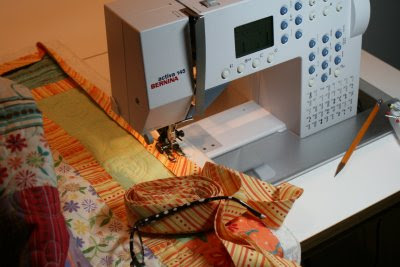Let's look at the list I wrote on Wednesday night:
1. Finish the lap quilt for my Prayer Sister, Maria - done! I'll post a photo later in the week; the weather today simply did not cooperate with picture-taking.
2. Finish a project I am secretly doing as a gift - done! But I can't post a photo until after the giving of the gift.
3. Begin sewing the blocks for Tammy's Asian Strip Gift Quilt - begun! I actually sewed 20 of the 30 blocks. This quilt goes together fast.
4. Make a wool skirt. I'm in dire need of winter clothes - done! And I am very pleased.
The wool skirt is my tried-and-true skirt pattern, McCalls # 3341:

I've made this skirt from cotton, rayon, and wool. I've made the above-the-knee version and below-the-knee. It has no waistband, and is simply faced. If I don't line it, it takes me three hours to make it, from the cutting out stage to the hem. As I was making the above-the-knee version from wool I got from Gorgeous Fabrics, I lined it in a luxurious silk charmuese I got from Fashion Fabrics Club.


I line all my wool skirts in silk - it feels luscious, and if you get the silk on sale, it really doesn't cost much more than quality lining. And I believe that is the real advantage of sewing your own clothes; you can make it in a way that you really can't find in ready-to-wear. How much would you have to pay for a skirt lined in real silk? Too much.
The wool is a black and tan check:

I know it doesn't look like much on the hanger, but I love the way it fits and the silk makes it a joy to wear - it is warm, but the fabric breathes. Here are shots of the lining inside:


The lining is free-hanging; I've done it both ways, but today I was in the mood for a free hanging hem. One thing I did differently on this skirt was to cut out the skirt and lining using a rotary cutter rather than scissors. I can't say the rotary cutter was superior in any respect, but I suspect that my lack of experience makes me unqualified to really say. I was mostly paranoid that I would accidentally cut into the pattern. So then I ended up with portions where I didn't cut closely enough. My verdict is that I need more experience with the rotary cutter.
I finished the skirt seam allowances with my Bernina overlock stitch (stitch number 3), but I finished the lining seam allowances with pinking shears, which I normally avoid like the plague because nothing screams home made more than pinked seam allowances, but given that this was a lining and which no one will see, I went ahead.
I hope everyone had a productive Thanksgiving and I look forward to seeing your projects.
Parting shot: My Prayer Group! Maria, Jamie, me, Donna, and Judy. We took this today after Mass in honor of Advent. Not pictured is the Other Donna, as we call her.



























 For the third stack, move the top 7 fabrics to the bottom. For the fourth stack, move the top 11 fabrics to the bottom. For the fifth stack, move the top 14 fabrics to the bottom. So my stacks look like this:
For the third stack, move the top 7 fabrics to the bottom. For the fourth stack, move the top 11 fabrics to the bottom. For the fifth stack, move the top 14 fabrics to the bottom. So my stacks look like this:

 Now sew your sashing fabric to the top and bottom of your quilt. Next sew four of your 4 inch border fabrics together. Add a four inch piece of sashing to a corner square and sew the corner square to each end of the border. Do this for both the top and bottom. Like this:
Now sew your sashing fabric to the top and bottom of your quilt. Next sew four of your 4 inch border fabrics together. Add a four inch piece of sashing to a corner square and sew the corner square to each end of the border. Do this for both the top and bottom. Like this:








 My great-grandmother was Daisy Snell Payne. (I love the name Daisy, don't you? It sounds so sturdy and honest and old fashioned.) I don't have a photo to show you, but I can tell you that she looked like a proper great-grandmother, full-figured with an impressive bosom upon which her favorite brooch rested. She wore glasses and had grey hair. She died during WWII, in 1944, I believe, of cancer, according to my father. He remembers her as an enthusiastic quilter, with a quilting rack suspended from ropes from the ceiling of one of the bedrooms in the old farmhouse. The rack would be lowered when her sewing bee came over to help quilt the quilts she had handpieced together.
My great-grandmother was Daisy Snell Payne. (I love the name Daisy, don't you? It sounds so sturdy and honest and old fashioned.) I don't have a photo to show you, but I can tell you that she looked like a proper great-grandmother, full-figured with an impressive bosom upon which her favorite brooch rested. She wore glasses and had grey hair. She died during WWII, in 1944, I believe, of cancer, according to my father. He remembers her as an enthusiastic quilter, with a quilting rack suspended from ropes from the ceiling of one of the bedrooms in the old farmhouse. The rack would be lowered when her sewing bee came over to help quilt the quilts she had handpieced together. 



 Not so good here:
Not so good here:


